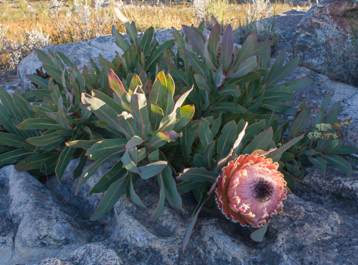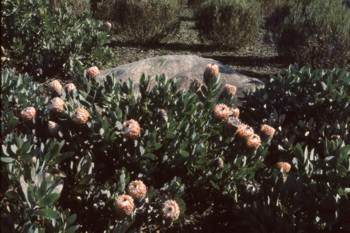Protea magnifica
Protea magnifica Link
Family: Proteaceae
Common names: queen protea, queen sugarbush, bearded protea ( Eng. ); wolbaardsuikerbos ( Afr. )
SA Tree No: 86.1
Introduction
Protea magnifica has the second largest flower head after P. cynaroides, the king protea. The queen protea is one of the most attractive and sought after proteas. No picture can describe how strikingly beautiful and fluffy it is with flower head colour varying naturally. With its rounded bushy form, this protea will look great in any garden environment.

Description
Description
Protea magnifica is indeed a variable protea, ranging from small erect trees of about 3m in height, to low sprawling shrubs among rocks and some that grow horizontally on the ground. Cultivated plants bought from nurseries generally grow into rounded bushes, ranging from 1.5-2.0m in height and 2-4m in diameter.

Protea magnifica has a single, stout main stem. The leaves are variable, large, and hairy when young but become leathery and grey green (glaucous) when mature, 100-200mm long and 30-60mm wide. They are prominently veined and have red to yellow midribs.
The massive woolly flower head is large and cup-shaped, and measures 150-160mm long and 150mm across. In nature the colour range of the outer floral bracts is broad, including greenish cream, cream, pink, salmon pink, rosy reds and deep carmine. The bract beards are variable in colour and density. They may be white, purple-black or tawny brown with the central tip being black, tawny brown or even white. Flowering time may differ from locality to locality but is mainly from mid-winter to mid-summer (June to January) peaking in spring (September). The seeds are retained on the bush.

Protea magnifica is slow growing and is one of the longer-lived proteas if in suitable conditions. Some have been known to reach 30 years of age in cultivation.
Conservation Status
Status
Currently, this plant is Red Listed as Least Concern (LC), meaning that it is not threatened. It is locally common in isolated dense stands and sometimes as individual plants.
Distribution and habitat
Distribution description
Protea magnifica is widespread over almost all the major mountain ranges in the southwestern Cape from the Skimmelberg and Koue Bokkeveld to the Hottentots-Holland Mountains, Klein Swartberg, Riviersonderend Mountains and central Langeberg. Here the plants receive rain, mist or snow in winter but are always exposed to hot dry weather in summer. They can be found at altitudes ranging from 1200-2700m, where they grow on soils that are generally nutrient poor, acidic and well drained. They are most often found sprawling along rocky areas and steep slopes where they are reasonably safe from fires.
Derivation of name and historical aspects
History
In 1806 Henry Andrews published a large colour plate of Protea magnifica that he prepared from a specimen flowering in George Hibbert's conservatory in London. It was the first record of the plant flowering in cultivation. The exact date of its discovery is unknown but it is thought to be around 1798, this was when Hibbert's collector, James Niven arrived in the Cape and gathered the seeds from the Hottentots Holland Mountains.
This species was grown at the Royal Garden in Berlin in 1820 under Dr H.F. Link and at Woburn Abbey until 1830 by the Duke of Bedford. It was unfortunate that not many where successful in growing this species, and there was not much interest in Protea magnifica as a garden ornamental until 1916 when Kirstenbosch raised a few seedlings. Today it is one of the most sought after proteas by growers, both privately and commercially.
Carl Linnaeus, the father of taxonomy, named this genus in 1735 after Proteus, a god in Greek mythology who could change into many forms, like the many different forms of the Proteaceae family. The specific epithet magnifica means magnificent or glorious. Protea magnifica was previously known as Protea barbigera. Barbigera meaning bearded, referring to the fringe of long hairs on the floral bracts.
The Proteaceae family is diverse, comprising 80 genera and more than 1700 species occurring in Africa, Madagascar, Southeast Asia, Malaysia, the Pacific Islands, Australia and South America. In South Africa there are 14 genera and 352 species.
Ecology
Ecology
Most proteas in South Africa are pollinated by insects such as bees, scarab beetles, monkey beetles, and bird species like the Cape Sugarbird ( Promerops cafer ), Orange-breasted Sunbird ( Anthobaphes violacea ), and the Southern Double-collared Sunbird ( Cinnyris chalybeus ). Protea magnifica is most likely pollinated by birds.
Proteas form part of fynbos which is a vegetation type that is prone to fires. Most fynbos have adopted a re-seeding or resprouting strategy to survive fires. Protea magnifica is a re-seeder--the mother plant will die but the population survives because of the masses of seeds produced by the plant over the years and stored in old flower heads on the plant. Seeds are released after the fire and are dispersed by wind. Protea magnifica is a slow grower and populations do not thrive where fires are frequent. In nature most plants are found in rocky outcrops and on steep slopes where they are safe from fires.

Uses
Use
Protea magnifica is cultivated as a cut flower for the export market because of its excellent characteristics of having long stems, long lasting flower heads and a good vase life. Its air and sea freight ability is very good. With regular requests for P. magnifica from all over the world, it has a remarkably high economic potential. It is considered one of the most prized cut flowers due to its longevity and ability to be used in dried flower arrangements.
There are many good-looking Protea magnifica hybrids cultivated as cut flowers and sometimes made available as garden shrubs, including P. magnifica x burchellii `Sheila', P. magnifica x compacta `Lady Di', P. magnifica x longifolia `Pinita', P. magnifica x obtusifolia `Candida', P. magnifica x susannae `Susara', P. compacta x magnifica `Andrea', P. compacta x magnifica `Pink Velvet' and P. laurifolia x magnifica `Niobe'. There are also a few cultivars, such as P. magnifica `Snow Queen', `Chelsea' and `Atlantic Queen'.

Growing Protea magnifica
Grow
Protea magnifica is a spectacular garden shrub in many situations. It requires good drainage and will not do well in damp, humid gardens. It prefers to be planted in full sun and must have good air circulation.
It is an easy plant to grow in well-drained acid soils and can tolerate frost up to about -8°C and can withstand some wind, but may show signs of foliage burn from excessive salt winds. They do not grow well along coastal ranges that are covered with moist fog through the year. Do not disturb their roots as protea roots are very susceptible to infection if they are tampered with. Proteas are light feeders that have adapted to very nutrient-poor soils and will die if strong fertilizers and manure are used.
Protea magnifica can be propagated from seed or from cuttings. Seed germination is somewhat unpredictable, starting as early as 21 days after sowing and continuing for up to two months. Sow the seeds in autumn (mid-March) into well-drained soil and lightly cover with sand or fine-milled bark and keep moist. Once the seeds start to develop their first true leaves, transplant them into individual containers. Seedling growth after germination is slow as most of them take up to six years to reach flowering stage.
Cuttings can be taken from semi hard wood in late spring or autumn. Collect cuttings from disease-free plants that are not yet flowering. Leaves on the basal third of the cutting should be stripped off and ensure that the cutting is cut just above a potentially sprouting bud. Dip the cutting in a rooting hormone and place into a well-drained medium under intermitted mist with a bottom heat of 25°C. Cuttings will ensure that the desired characteristics are maintained, whereas plants sown from seed might show variation from the parent plant particularly in flower colour.
The plant is not noticeably affected by insect pests but can be seriously affected by fungal diseases of the leaves. This normally happens when the plant is grown in humid or shaded localities. The fungal disease manifests themselves as deep reddish-maroon blotches on the leaves, which is followed by defoliation. A good way to prevent this from happening is to spray the plant regularly from seedling stage to maturity with a copper-oxychloride based fungicide. However seriously diseased, adult plants rarely respond to treatment and should rather be removed and destroyed.
References
- Duncan, G., Brown, N., Nurrish, L. 2013. Grow Proteas . Kirstenbosch Gardening Series, National Botanical Institute, Cape Town.
- Matthews, L. 1993. Proteas of the world . Bok Books, Durban, in association with David Bateman Ltd, Auckland, New Zealand.
- Matthews, L. 1993. The Protea growers handbook including Leucadendron, Banksias and Grevilleas . Bok Books, Durban.
- Rebelo, A. 2001. Proteas. A field guide to the proteas of southern Africa, edn 2. Fernwood Press, Cape Town.
- Rourke, J.P. 1982. The proteas of southern Africa. Centaur Publishers, Johannesburg.
- Vogts, M. 1982. South Africa's Proteaceae: know them and grow them. Struik, Cape Town.
- website: Plants of southern Africa : an online checklist. http://posa.sanbi.org.
Credits
Melissa van der Burg
Kirstenbosch National Botanical Garden
January 2014
Acknowledgments: The author thanks Alice Notten for helping with this article and Adam Harrower for pictures of Protea magnifica in habitat.
Plant Attributes:
Plant Type: Shrub, Tree
SA Distribution: Western Cape
Soil type: Sandy
Flowering season: Spring, Early Summer, Winter
PH: Acid, Neutral
Flower colour: Red, White, Pink, Cream
Aspect: Full Sun
Gardening skill: Challenging
Special Features:
Horticultural zones







Rate this article
Article well written and informative
Rate this plant
Is this an interesting plant?
Login to add your Comment
Back to topNot registered yet? Click here to register.